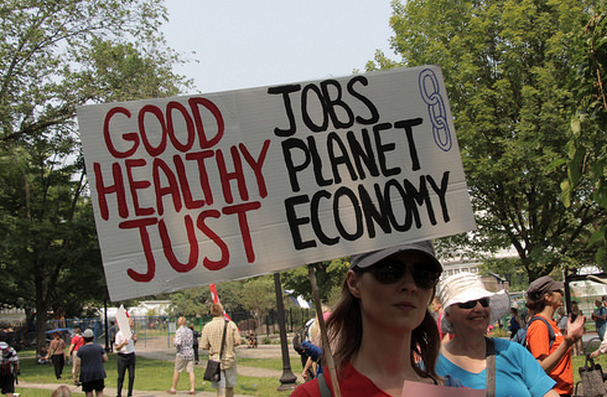Can the PRO Act Ease Green-Labor Tensions?

Much of my professional career has resolved around the tricky policy questions of building so-called blue-green alliances and undermining the tensions between the labor and environmental movements. As such, I always find Kate Aronoff an important read. She has a recent piece on how the PRO Act might help ease those tensions.
A coalition led by the International Union of Painters and Allied Trades, or IUPAT, and the Communication Workers of America is mobilizing to push the PRO Act over the finish line in the Senate. The youth climate group Sunrise Movement was an early recruit, and the Democratic Socialists of America—including its ecosocialist working group, which is also pushing for a Green New Deal—will be deploying its members in key districts around the country to ensure it’s passed. After a kick-off call over the weekend featuring Congressman Jamaal Bowman, Association of Flight Attendants-CWA head Sara Nelson, and Naomi Klein, DSA is holding trainings for its members throughout March as well as events around the country pushing key senators to back the bill in the lead-up to May Day. Sunrise last week launched a Good Jobs for All campaign, which is urging on a federal job guarantee introduced recently by Representative Ayanna Pressley. Over the next several weeks, Sunrise hubs will be working alongside progressive legislators and holding in-district protests to advance five priorities for upcoming infrastructure legislation, including the PRO Act. After its passage through the House last night, a press release from the groups praised the measure as a “core pillar of the Green New Deal.”
…
The left, including many young climate organizers pushing for a Green New Deal, has a different theory of change and approach to coalition-building. A new generation of climate organizers see workers as a critical piece of the mobilization needed to pass any sweeping climate legislation and create a more sustainable world. Labor reforms like the PRO Act, they reason, are necessary for making both possible. Climate organizers are also all too conscious of the high-level negotiations among Beltway insiders that have failed in the past. The Wagner Act of 1935 offers some prior proof of concept, having helped build the coalition that pushed the New Deal to go further and faster, following strikes in the 1930s. Working with labor in that sense is less a matter of risk management than of working toward shared interests.
Sydney Ghazarian coordinates DSA’s Green New Deal campaign. “The only way that a Green New Deal can live up to the promise of creating millions of union jobs is if workers can collectively organize for their needs,” she tells me. “The PRO Act won’t magically make a mass workers’ movement happen, but it does eliminate some of the structural barriers that are preventing that from happening.… People are happy to point to the fact that the clean energy economy is one of the fastest-growing sectors, but what’s left out of the equation is whether these are good jobs. By passing the PRO Act, we can provide proof of concept: We can make these jobs good jobs.”
Daniel Dominguez, whose day job is with the National Union of Healthcare Workers, has been helping lead DSA’s work on the PRO Act as a member of the Los Angeles chapter and part of its Democratic Socialist Labor Commission, a national body. “There’s a pretty broad recognition from our membership that a lot of our key demands are going to need a strong labor movement. The PRO Act on its own is not the transformational change we’re looking for but is a prerequisite for things like a Green New Deal and a federal job guarantee.”
I really do feel the generational side of this is important. The ways in which young people identify as both environmentalists and as people interested in economic equality are different than that of even 15 years ago. On the environmentalist side, there’s a lot more interest in climate and environmental justice issues than in wilderness. A growing movement for economic equality has happened almost completely outside the labor movement and now is really starting to impact that movement with new energy. The debates of the 1990s are not the debates of the 2020s. There is real potential here.
Of course, the PRO Act isn’t going to pass without filibuster reform. But one thing this logjam also does is create incentives for different movements to join together to push through it. Those alliances can also lead to bigger change. There is reason to be optimistic about the potential for real labor-environmentalist alliances going forward.


